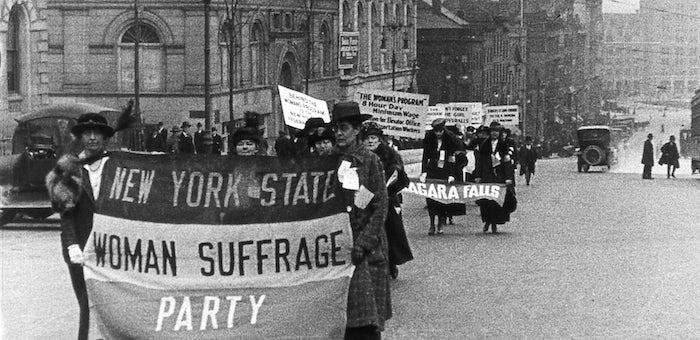
Women's suffrage demonstrators in 1919
Download a sample list of available titles and additional research resources at UCLA in PDF format.
UCLA's Hearst Metrotone News Collection is one of the largest newsreel collections in the world. It contains over 27 million feet of distributed newsreels, unreleased stories and outtakes.
The Hearst newsreel went through a series of incarnations. Beginning in the 1910s, these newsreels were first envisioned as a way to boost Hearst-owned newspaper readership. The tabloid style of Hearst papers would heavily influence the style and content of the newsreels, and arguably television news forms as well. The silent Hearst reels covered topics such as the First World War, the Black Sox Scandal, adventurous aviators and North Pole explorers. European royalty were given special attention in the newsreels. The attraction of celebrity served the reel further when it became half-owned by MGM. Distributed by MGM from the 1930s through the late 1960s, the newsreels often promoted the studio’s stars and features in the guise of news.
Although the reels were fashioned for the most part to be entertaining, they uniquely document the events of their time. During their heyday, the newsreels presented everything from the battle for recovery from the Depression to the battles of WWII. The onset of television news ended the golden age of the newsreel, but it nonetheless continued to be distributed theatrically well into the 1960s. In addition to providing on-site viewing at the Archive Research and Study Center (ARSC), the Archive's Media Licensing department licenses footage to a variety of U.S. and international productions, including feature films, television documentary series and museum exhibitions.
Partnership with The Packard Humanities Institute and online access project
In 1981, the Hearst Corporation donated its newsreel collection to the University of California. In cooperation with the Archive, The Packard Humanities Institute (PHI) is developing a website (newsreels.net) as part of a joint project, formed in 2014, to make the Hearst newsreel collection more easily accessible to the public. The site currently contains footage from thousands of items, about 15% of the collection, along with some of the original Hearst documentation. The website is a work in progress and will expand and change as more material is added.
The website currently offers three ways of searching the collection:
Released newsreels: newsreels shown in theaters between September 1929 and December 1967. Currently, this includes scans of most of the footage from 1946 to 1967 with a smaller selection of footage from 1929 through 1945.
Unreleased materials: footage either shot by the Hearst Corporation but never theatrically released or footage purchased from other newsreel companies both foreign and domestic. These scans are only a small sampling of vault material from the collection. The newsreels on the site are labeled as “Vault Materials.”
Sample Topics: PHI has created a list of sample topics of Hearst footage. A preliminary list is labeled the “Eisenhower Years” (1953 to 1962). Additional information about the site’s navigation and regarding the Packard Humanities Institute can be found directly on the website.
A small selection of newsreels can also be found at the Archive’s YouTube channel.
For questions about licensing footage from the website, please contact our Media Licensing department at footage@cinema.ucla.edu.
For general questions about the Hearst Metrotone News Collection, please contact the Senior Newsreel Preservationist at jbickel@cinema.ucla.edu.
Newsreels are records of the past. They reflect the attitudes and prejudices of the times in which they were produced. This page and the newsreels.net are presented as resources for historical and cultural research and to promote public awareness of the past. Neither the UCLA Film & Television Archive nor the Packard Humanities Institute endorses all the views depicted in the images and commentary of the newsreels, some of which could be disturbing or offensive to users.
< Back to Motion Picture Collection profiles






 Mobile Navigation
Mobile Navigation
